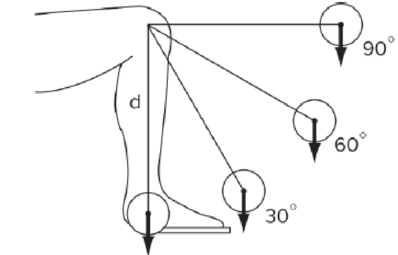
BASIC BIOMECHANICS
8th Edition
ISBN: 9781259913877
Author: Hall
Publisher: RENT MCG
expand_more
expand_more
format_list_bulleted
Concept explainers
Textbook Question
Chapter 13, Problem 5AP
A patient rehabilitating a knee injury performs knee extension exercises wearing a 15-N weight boot. Calculate the amount of torque generated at the knee by the weight boot for the four positions shown, given a distance of 0.4 m between the weight boot’s CG and the joint center at the knee. (Answers: a. 0; b. 3 N-m; c. 5.2 N-m; d. 6 N-m)

Expert Solution & Answer
Want to see the full answer?
Check out a sample textbook solution
Chapter 13 Solutions
BASIC BIOMECHANICS
Ch. 13 - Why does a force directed through an axis of...Ch. 13 - Why does the orientation of a force acting on a...Ch. 13 - A 23-kg boy sits 1.5 m from the axis of rotation...Ch. 13 - Prob. 4IPCh. 13 - Two people push on opposite sides of a swinging...Ch. 13 - Prob. 6IPCh. 13 - Prob. 7IPCh. 13 - Prob. 8IPCh. 13 - A 10-kg block sits motionless on a table in spite...Ch. 13 - Prob. 10IP
Ch. 13 - A 35-N hand and forearm are held at a 45 angle to...Ch. 13 - A hand exerts a force of 90 N on a scale at 32 cm...Ch. 13 - A patient rehabilitating a knee injury performs...Ch. 13 - A worker leans over and picks up a 90-N box at a...Ch. 13 - A man carries a 3 m, 32-N board over his shoulder....Ch. 13 - A therapist applies a lateral force of 80 N to the...Ch. 13 - Tendon forces Ta and Tb are exerted on the...
Knowledge Booster
Learn more about
Need a deep-dive on the concept behind this application? Look no further. Learn more about this topic, bioengineering and related others by exploring similar questions and additional content below.Similar questions
- What is the function of the sarcoplasmic reticulum in muscle cell contraction?arrow_forwardThe specialized soft-tissue manipulation technique used to ease the pain of conditions such as fibromyalgia, movement restrictions, and temporomandibular joint disorders is known as ____________________________ myofascial release occupational therapy RICE therapeutic ultrasoundarrow_forwardWhat are the structural and functional differences between slow and fast muscle?arrow_forward
Recommended textbooks for you
- Lifetime Physical Fitness & WellnessHealth & NutritionISBN:9781337677509Author:HOEGERPublisher:Cengage
 Human Physiology: From Cells to Systems (MindTap ...BiologyISBN:9781285866932Author:Lauralee SherwoodPublisher:Cengage LearningSurgical Tech For Surgical Tech Pos CareHealth & NutritionISBN:9781337648868Author:AssociationPublisher:Cengage
Human Physiology: From Cells to Systems (MindTap ...BiologyISBN:9781285866932Author:Lauralee SherwoodPublisher:Cengage LearningSurgical Tech For Surgical Tech Pos CareHealth & NutritionISBN:9781337648868Author:AssociationPublisher:Cengage

Lifetime Physical Fitness & Wellness
Health & Nutrition
ISBN:9781337677509
Author:HOEGER
Publisher:Cengage

Human Physiology: From Cells to Systems (MindTap ...
Biology
ISBN:9781285866932
Author:Lauralee Sherwood
Publisher:Cengage Learning

Surgical Tech For Surgical Tech Pos Care
Health & Nutrition
ISBN:9781337648868
Author:Association
Publisher:Cengage



GCSE PE - ANTAGONISTIC MUSCLE ACTION - Anatomy and Physiology (Skeletal and Muscular System - 1.5); Author: igpe_complete;https://www.youtube.com/watch?v=6hm_9jQRoO4;License: Standard Youtube License